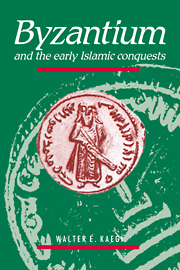Book contents
- Front Matter
- CONTENTS
- List of illustrations
- Preface
- List of abbreviations
- Chapter 1 The problem of Byzantium and the early Islamic conquests
- Chapter 2 The Byzantine Empire in an era of accelerating change
- Chapter 3 Difficulties in devising defenses for Syria
- Chapter 4 The first Muslim penetrations of Byzantine territory
- Chapter 5 Early tests in southern Palestine
- Chapter 6 Problems of cohesion: the battle of Jābiya- Yarmūk reconsidered
- Chapter 7 The brief struggle to save northern Syria and Byzantine Mesopotamia
- Chapter 8 Byzantium, Armenia, Armenians, and early Islamic conquests
- Chapter 9 Controversy and confidence in the seventh-century crisis
- Appendix 1 Author and date of the anti-jewish treatise
- Chapter 10 Elements of failure and endurance
- Bibliography
- Index
Chapter 9 - Controversy and confidence in the seventh-century crisis
Published online by Cambridge University Press: 22 September 2009
- Front Matter
- CONTENTS
- List of illustrations
- Preface
- List of abbreviations
- Chapter 1 The problem of Byzantium and the early Islamic conquests
- Chapter 2 The Byzantine Empire in an era of accelerating change
- Chapter 3 Difficulties in devising defenses for Syria
- Chapter 4 The first Muslim penetrations of Byzantine territory
- Chapter 5 Early tests in southern Palestine
- Chapter 6 Problems of cohesion: the battle of Jābiya- Yarmūk reconsidered
- Chapter 7 The brief struggle to save northern Syria and Byzantine Mesopotamia
- Chapter 8 Byzantium, Armenia, Armenians, and early Islamic conquests
- Chapter 9 Controversy and confidence in the seventh-century crisis
- Appendix 1 Author and date of the anti-jewish treatise
- Chapter 10 Elements of failure and endurance
- Bibliography
- Index
Summary
THE CHALLENGE OF FLUCTUATING MOODS
Seventh-century Byzantine perceptions of the critical sequence of genuine military and political disasters in Asia and Europe took shape in an empire already convulsed with religious controversies. Texts that were contemporary or almost contemporary with the Islamic conquests provide clues to contemporary moods, attitudes, and responses. Seventh-century sources of any kind are rare, and among the rarest are those that attempt any explanation or rationalization.
Soon after the loss of Palestine, Syria, and Egypt seventh-century Byzantines recorded some of their impressions about these disasters. Their brief mentions of events contributed to the creation of the later historiography of what had happened. They believed that decisive battles had marked the key stages of their losses and eventual ruin at the hands of the Muslims. Thus St. Anastasius the Sinaite (d. c. 700 or shortly after) expressed it: “the first and fearful and incurable fall of the Roman [Byzantine] army, I mean the bloodshed at Gabitha [Jābiya] and Yarmūk and Dathesmon [Dathin], after which there were the captures and burning of [provinces of] Palestine and Caesarea and Jerusalem, then the Egyptian destruction, and in order the imprisonments and incurable devastations of the peninsulae and islands of all Romania.” It was disastrous battles that stood out in the memory of contemporaries as the initial part of the Byzantine catastrophe.
- Type
- Chapter
- Information
- Byzantium and the Early Islamic Conquests , pp. 205 - 230Publisher: Cambridge University PressPrint publication year: 1992



